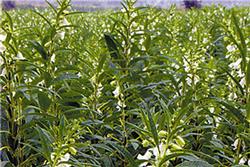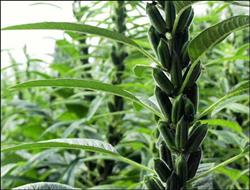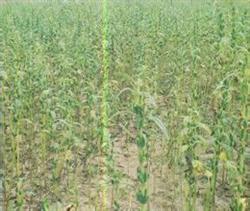What should be paid attention to in sesame planting?

What should be paid attention to in sesame planting? Please introduce sesame in detail, which is rich in protein, vitamins, iron, calcium, sesame phenols and other substances. It is rich in nutrition and rich in aroma. It is an indispensable ingredient for making cakes and characteristic foods. Sesame oil is a rare excellent edible oil. Sesame is a temperature-loving crop, and July is the best time for autumn sowing of sesame. Sesame is suitable to be cultivated in sandy soil with loose soil and good drainage. The whole growth period is generally 85-95 days, and the yield per mu is 80-100 kg. Sesame seeds are available in black and white. The yield of black sesame is higher than that of white sesame, but its oil content is lower than that of white sesame. At present, the main varieties of sesame planted are: Dongzhi 8, Dongzhi 10. The two varieties are white sesame, the general yield per mu is about 80 kg, and the high yield can reach more than 100 kg. The whole growth period is about 90 days, and the above two varieties are crossbred by the Oil crop Research Institute of the Chinese Academy of Agricultural Sciences. There are local farm varieties of black sesame, the seed color is black and bright, strong aroma, the general yield per mu of about 100 kg, the whole growth period of about 95 days. Sesame should rotate with soybeans, corn and peanuts, not continuous stubble, in order to reduce the disease. Sesame seeds are small, with a seed amount of 300 grams per mu. Before sowing, fine soil preparation should be achieved, and sufficient base fertilizer should be applied, with 20 piculs of miscellaneous fertilizer per mu of farm soil. 50 kilograms of lime per mu should be applied to the highly acidic soil to adjust the soil pH to facilitate the normal growth of sesame. Sow seeds on sunny days to prevent the soil from hardening after rain. In order to make the sowing evenly, the method of sowing seeds mixed with coke mud ash is generally adopted, that is, the seeds are mixed into fine mud or coke ash, mix well, adopt the way of strip sowing, and do not cover the soil with feet after sowing. After emergence, the seedlings were interspersed for 2 to 3 times, and the seedlings were fixed for the first time in a pair of true leaf stage, and the seedlings were fixed in 3 pairs of true leaf stage. The fixed seedling density was about 10 000 plants per mu for branch type varieties and about 15000 plants per mu for single stem type varieties. After setting the seedling, it is necessary to plough and hoe the grass for 2 or 3 times in time, combined with clearing the ditch to cultivate the soil to achieve the requirements of loosening soil, eliminating weeds and preventing lodging. In the budding stage, sesame seeds should be well fertilized with flower buds, 10 kg of urea per mu should be flushed and irrigated, and 0.3% potassium dihydrogen phosphate should be used for extra-root topdressing at full flowering stage, which plays a better role in increasing grain weight and oil content and increasing yield. The main diseases of sesame are: blight, anthracnose and powdery mildew. Carbendazim, topiramate and mancozeb can be used to control the occurrence. The main pests are ground tiger, aphid, night moth, and chlorpyrifos and imidacloprid. When the fruit of sesame changes from turquoise to yellow, it means that the seeds are ripe and can be harvested. When harvesting, cut off 5 cm near the ground and tie it into a handle. every 3 brackets are erected and exposed to the sun. When most of the fruits are cracked, they are threshed and then exposed to the sun. Generally, they can be removed after three times. Click to get more sesame planting techniques click to get more food crop planting techniques
- Prev

Is there any way to increase production by planting sesame?
Is there any way to increase production by growing sesame? Please introduce sesame to increase production can refer to the following methods: 1. Spray short and strong element in time. When used in the sesame seedling stage, it can make the sesame stem and branch stout, the capsule position reduced, the node more capsule, the grain weight increased, and the yield increased by 35%. The method of use is to spray continuously at the true leaf stage of 2-3 pairs of sesame seeds.
- Next

What can prevent sesame leaf blight?
What can prevent sesame leaf blight? Please introduce the distribution and damage of sesame leaf blight: it occurs in all sesame producing areas in China. The disease is caused by the fungus Corynespora hyacinth. In addition to harm sesame, but also harm soybeans, straight beans and other crops. Symptoms/morphological characteristics: leaves and stems die after seedling damage;...
Related
- The first cup of black tea in spring, the flavor and history of tea gardens in Kenya, Africa
- The computer can not only choose potatoes, but also grow tea rice. AI will grow winter oolong tea champion.
- It is not only the inflated tea bitten by insects, but also engraved with the four seasons tea in Beipu.
- The Oriental Beauty Tea Festival in Zhuxian County takes the stage at the weekend to experience the plus-size feast of oil tea.
- & quot; Oriental Beauty Tea & Exploration of Emei in Hsinchu, the hometown of quot;
- The new variety of strawberry "Tainong 1" dessert is the first choice with mellow aroma. Crimson gorgeous
- History of Tea in Taiwan: from Wild Inner Mountain to Export Tea Garden
- Two types of Taiwan Oriental Beauty Black Tea won the British three-Star Award for Childhood Tea Xiang Zhang Jiaqi changed from pilot to champion tea maker.
- Banana species and varieties: the planting history of Taiwan Xianren banana and dwarf banana is long, is banana disease resistant?
- Coffee planting Technology: Qianjie Coffee from Seedling to harvesting

